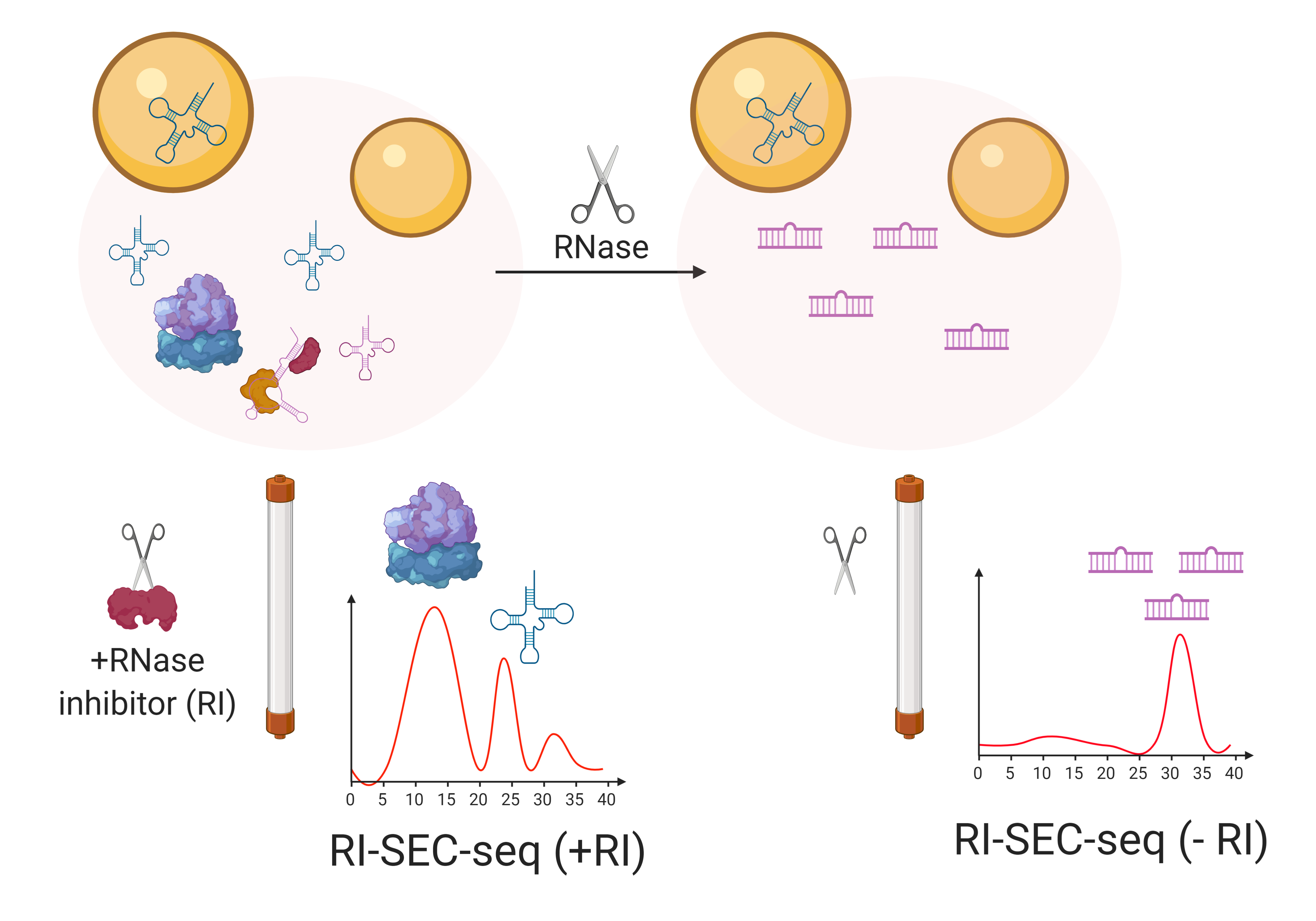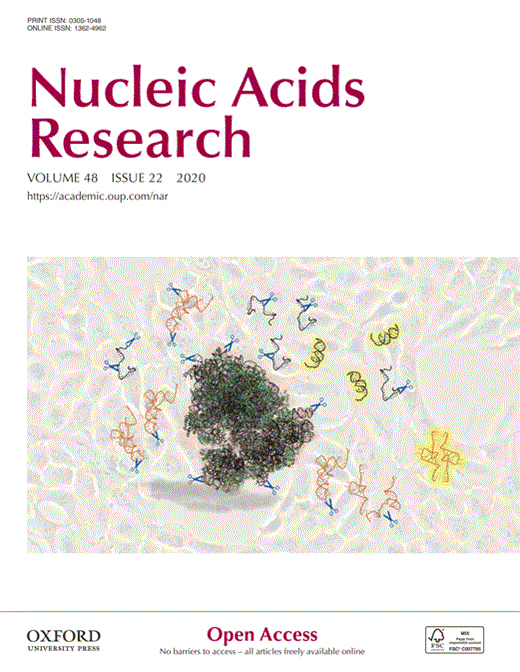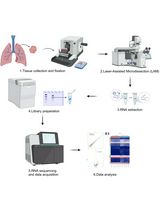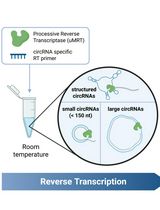- EN - English
- CN - 中文
RI-SEC-seq: Comprehensive Profiling of Nonvesicular Extracellular RNAs with Different Stabilities
RI-SEC-seq:具有不同稳定性的非泡性细胞外RNA的综合分析
发布: 2021年02月20日第11卷第4期 DOI: 10.21769/BioProtoc.3918 浏览次数: 5712
评审: RAMESH KUDIRAJuliang QinShaoxin XU
Abstract
Exosomes and other extracellular vesicles (EVs) are considered the main vehicles transporting RNAs in extracellular samples, including human bodily fluids. However, a major proportion of extracellular RNAs (exRNAs) do not copurify with EVs and remain in ultracentrifugation supernatants of cell-conditioned medium or blood serum. We have observed that nonvesicular exRNA profiles are highly biased toward those RNAs with intrinsic resistance to extracellular ribonucleases. These highly resistant exRNAs are interesting from a biomarker point of view, but are not representative of the actual bulk of RNAs released to the extracellular space. In order to understand exRNA dynamics and capture both stable and unstable RNAs, we developed a method based on size-exclusion chromatography (SEC) fractionation of RNase inhibitor (RI)-treated cell-conditioned medium (RI-SEC-seq). This method has allowed us to identify and study extracellular ribosomes and tRNAs, and offers a dynamical view of the extracellular RNAome which can impact biomarker discovery in the near future.
Graphical abstract:

Overview of the RI-SEC-seq protocol: sequencing of size-exclusion chromatography fractions from nonvesicular extracellular samples treated or not with RNase inhibitors (+/- RI)
Background
Extracellular RNAs (exRNAs) are involved in intercellular communication and are promising disease biomarkers in minimally invasive liquid biopsies (O’Brien et al., 2020). To be transported in human bodily fluids, exRNAs need to achieve some degree of protection against extracellular ribonucleases, which are ubiquitous in the extracellular milieu. By far, the most studied and best understood mechanism is RNA encapsulation inside extracellular vesicles (EVs) and release of these endogenous lipid nanoparticles into the extracellular space (Kalluri and LeBleu, 2020). Beyond simply protecting exRNAs from degradation, EVs contain a set of surface proteins which are involved in cellular uptake (Hoshino et al., 2015), behaving as vehicles for RNA transfer between cells. This can occur both physiologically (Thomou et al., 2017) or under therapeutic biotechnological setups (Kamerkar et al., 2017; Kojima et al., 2018).
Much less is known about those exRNAs which are not associated with EVs (Li et al., 2018). However, early work has shown that the majority of microRNAs in human plasma are forming soluble ribonucleoprotein complexes with Argonaute 2 and are not transported inside EVs (Arroyo et al., 2011; Turchinovich et al., 2011). Later work has shown that the RNA content of EVs is not as high as previously suggested (Chevillet et al., 2014) and we have observed that most exRNAs in cell culture media remain in ultracentrifugation supernatants (Tosar et al., 2015).
We were surprised to find that the majority of the small RNAs that we could sequence in ultracentrifugation supernatants of cell-conditioned medium were 5’ tRNA halves derived from glycine and glutamic acid issoaceptors (Tosar et al., 2015). These sequences were also the most abundant in blood plasma, serum and other biofluids (Srinivasan et al., 2019), where they also seemed to be transported outside EVs (Dhahbi et al., 2013). We later observed these sequences could form dimers and that these dimers were highly resistant to single-stranded ribonucleases (Tosar et al., 2018). These observations suggested that extracellular nonvesicular RNA profiles are prone to survivorship bias (Tosar et al., 2021), where we tend to see only those RNAs that are more resistant to degradation. Although this could be desirable for biomarker studies, it can be problematic for understanding RNA release mechanisms. Thus, we developed a method to study nonvesicular exRNAs irrespectively of their extracellular stability. This method, called RI-SEC-seq (for: size-exclusion chromatography [SEC] fractionation of RNase inhibitor [RI]-treated cell-conditioned medium), enabled us to study RNAs in the form they were effectively released from cells. Following this procedure, we discovered the presence of extracellular ribosomes and tRNAs, and the extracellular biogenesis of extracellular tRNA-derived fragments (Tosar et al., 2020). The latter was independently validated by others, using cell lines devoid of RNase I (Nechooshtan et al., 2020).
Here, we provide the experimental procedure so that readers can also obtain snapshots of the extracellular nonvesicular RNAome under low, intermediate and high RNase activities. This will help to characterize exRNA profiles in a comprehensive and dynamic manner, and to identify other stable RNAs with biomarker potential.
Materials and Reagents
T-75 flask (Corning, catalog number: 430641U )
0.22 µm or 0.45 µm membrane (Millipore, catalog number: GSWP04700 )
MCF-7 cell line (ATCC, ATCC® HTB-22TM), storage: liquid nitrogen when not in use. Cryopreservation: follow ATCC recommendations
1 ml syringe
14 ml, Open-Top Thinwall Ultra-Clear Tube, 14 × 95 mm, 50Pk (Beckman Coulter Life Sciences, catalog number: 344060 ), storage: room temperature
Vivaspin 20 centrifugal concentrator, MWCO 10 kDa, PES membrane (Sartorius, catalog number: VS2001 ), storage: room temperature
96 Well Standard Assay Block, 2 ml, Certified RNase/DNase free, for collection of chromatographic fraction (Costar, Corning Incorporated, catalog number: 3961 ), storage: room temperature
Superdex® 200 10/300 GL (GE Life Sciences, Sigma/Merck, catalog number: GE17-5175-01, discontinued product; alternative: Superdex® 200 Increase 10/300 GL, catalog number: GE28-9909-44 ), storage: room temperature
DMEM, high glucose, GlutaMAX TM Supplement (Gibco, Thermo Scientific, catalog number: 10569010 ), storage: 4 °C
Fetal bovine serum (FBS), qualified, origin: Brazil (Gibco, Thermo Scientific, catalog number: 12657029 ), storage: aliquoted (sterile) at -20 °C
MEGMTM Mammary Epithelial Cell Growth Medium BulletKitTM (Lonza, catalog number: CC-3150 ), storage: the basal MEBM medium is stored at 4 °C
Note: The MEGM SingleQuotsTM Supplements are stored at -20 °C. Once mixed, the complete MEGM medium is stored at 4 °C until expiry. We do not add the bovine pituitary extract or the antibiotics included in the kit.
DPBS, no calcium, no magnesium (Gibco, Thermo Scientific, catalog number: 14190144 ), storage: 4 °C. Use this sterile solution for cell culture
DPBS (10×), no calcium, no magnesium (Gibco, Thermo Scientific, catalog number: 14200075 ). Make 1× solution with ultrapure or DEPC (Diethyl pyrocarbonate)-treated water, filter, and use as mobile phase in size-exclusion chromatography
Trypsin-EDTA (0.05%), phenol red (Gibco, Thermo Scientific, catalog number: 25300062 ), storage: -20 °C
RNase inhibitor, murine (New England Biolabs, catalog number: M0314S ), storage: -20 °C
TRIzolTM reagent (Invitrogen, Thermo Scientific, catalog number: 15596018 ), storage: 4 °C
TRIzolTM LS reagent (Invitrogen, ThermoScientific, catalog number: 10296028 ), storage: 4 °C
2-propanol, for molecular biology (Sigma-Aldrich, catalog number: I9516-500ML ), storage: room temperature. Reagent needed for RNA purification based on the TRIzol method
Ethyl alcohol, pure, for molecular biology, storage: room temperature. Reagent needed for RNA purification based on the TRIzol method
Glycogen, RNA grade (Thermo Scientific, catalog number: R0551 ), storage: -20 °C. Reagent needed for RNA purification based on the TRIzol method
UltraPureTM DNase/RNase-Free Distilled Water (Invitrogen, ThermoScientific, catalog number: 10977035 ), storage: room temperature, sterile
Note: We do not use this water for large volumes of buffers such as those used in size-exclusion chromatography. For those purposes, we use MilliQ water that we validate as RNase-free in house. Autoclaved DEPC-treated water can be used instead. In this case, add DEPC (diethylpyrocarbonate, Sigma, catalog number: D5758 ) to a final concentration of 0.1% v/v, incubate overnight at room temperature and then autoclave to inactivate DEPC.
10× Tris-Borate-EDTA Electrophoresis Buffer (ThermoScientific, catalog number: B52 ), storage: room temperature
Acrylamide/bis-Acrylamide 30% solution, bioreagent, suitable for electrophoresis, 29:1 (Sigma-Aldrich, catalog number: A3574 ), storage: 4 °C. Hazardous (read MSDS)
SYBRTM Gold nucleic acid gel stain (10,000× concentrate in DMSO) (Invitrogen, ThermoScientific, catalog number: S11494 ), storage: -20 °C
RNA loading dye, 2× (New England Biolabs, catalog number: B0363S ), storage: -20 °C
QubitTM RNA HS Assay Kit (Invitrogen, ThermoScientific, catalog number: Q32852 ), storage: 4 °C
NEBNext® Multiplex Small RNA Library Prep Set for Illumina® (New England Biolabs, catalog number: E7300S ), storage: -20 °C
MiSeq Reagent Kit v2 (300-cycles) (Ilumina, catalog number: MS-102-2002 ), storage: -20 °C (box 1) and 4 °C (box 2)
Equipment
NovexTM TBE-Urea Gels (ThermoFisher, catalog number: EC6875BOX )
XCell SureLock Mini-Cell (ThermoFisher, catalog number: EI0001 )
ÄKTA pure FPLC system (Cytiva, former GE Life Sciences) with multiple wavelength detectors (at least capable of simultaneous detection at 280 and 260 nm) and an automatic fraction collector with capacity for 96 well assay blocks (Costar, 2 mL, RNase-free, catalog number: 3961 )
QubitTM Fluorometer 2.0 (Thermo Scientific, catalog number: Q32866 , discontinued product. Replaced by Catalog number Q33216 )
MiSeq Next Generation Sequencer (Illumina)
Software
Note: All software used for sequencing data analysis was run using the Galaxy Europe web interface (https://usegalaxy.eu).
fastx_clipper (fastx_toolkit)
Fastqc
RNA STAR
BAM filter
bamCoverage
featureCounts
Procedure
文章信息
版权信息
© 2021 The Authors; exclusive licensee Bio-protocol LLC.
如何引用
Tosar, J. P., Gámbaro, F., Castellano, M. and Cayota, A. (2021). RI-SEC-seq: Comprehensive Profiling of Nonvesicular Extracellular RNAs with Different Stabilities. Bio-protocol 11(4): e3918. DOI: 10.21769/BioProtoc.3918.
分类
分子生物学 > RNA > RNA 检测
癌症生物学 > 通用技术 > 分子生物学技术
癌症生物学 > 癌症生物化学 > 癌代谢
您对这篇实验方法有问题吗?
在此处发布您的问题,我们将邀请本文作者来回答。同时,我们会将您的问题发布到Bio-protocol Exchange,以便寻求社区成员的帮助。
Share
Bluesky
X
Copy link













